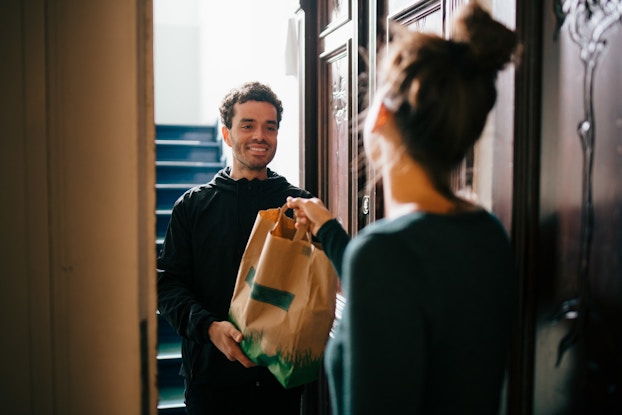
As a consumer, you may be familiar with apps like DoorDash, Uber Eats, and Grubhub for food delivery. Data from McKinsey estimates that the food delivery market has tripled in size since 2017, fueled by the pandemic and the demand for fast, convenient meals.
Delivery apps are no longer limited to the restaurant industry, nor are they exclusive to big enterprises. Retailers and other small businesses can use delivery apps to offer same-day shipping and curbside pickup. Here’s how delivery apps could work for your business.
Delivery apps for the food industry
Small businesses have a buffet of third-party delivery apps to choose from. In 2022, it’s estimated that 75% of independent restaurants used third-party delivery services.


Some of the most popular delivery apps include DoorDash, Grubhub, Uber Eats, Postmates, and Instacart. The benefit of working with these third-party services is that your restaurant or cafe is exposed to the tens of millions of monthly users who rely on these apps for food delivery. The platform you choose handles the logistics of sending orders and handling drivers, and you don’t have to carry the costs of wages, gas, and insurance for a team of drivers.
However, these apps usually charge a fee or commission for each order, and these fees can be steep. Uber Eats, for instance, charges a 30% fee for delivery orders (15% fee for self-delivery orders). For restaurants that already have tight margins, working with this platform can be unsustainable.
In addition, each platform caters to slightly different audiences. Instacart and Postmates offer grocery delivery, while Caviar claims to feature only the best spots in an area. Drizly is another option that offers alcohol delivery. It could take some trial and error to find out which platform is best for your local area.
Getting set up to offer delivery
Choosing the right delivery app is just one part of the equation. Each app works somewhat similarly. Sign up for the app and follow the prompts to list your restaurant, upload your menu, and link your listing to your point-of-sale system. When a customer browses the app, they can select menu items and order them through the interface.
Delivery apps are no longer limited to the restaurant industry, nor are they exclusive to big enterprises.
“The app sends these orders to you via a mobile device or a direct integration with your point-of-sale (POS), and then it connects you with local delivery drivers to deliver the orders,” explained FitSmallBusiness.
[Read more: How to Partner With a Third-Party Delivery Service]
There are other ways to accept orders for delivery and pickup, such as by connecting your Google Business profile. And some third-party apps are developing ways for retailers and service businesses to offer delivery or curbside pickup to capitalize on the convenience trend.
Delivery apps: not just for restaurants
There are a few ways to offer delivery to local customers near your retail location. Clover has an integration with small business POS systems to allow for online ordering and curbside pickup. Shopify also offers an option for local delivery using a third-party delivery service or having one of your staff drop off the order. “If an eligible customer's address is in your delivery area, then the customer has the local delivery as an option at checkout,” described the popular e-commerce platform. “You can offer delivery within a set distance from your location, or for certain postal codes.”
Uber has also expanded its Uber for Business offering to include options for businesses in the automotive, healthcare, hospitality, and real estate industries, among others. For instance, an auto repair shop could use Uber for Business to offer rides for customers while their vehicle is in the shop. Or a real estate agent could offer complimentary door-to-door rides to new tenants. It’s a unique way to provide “delivery” as a service business, where delivery doesn’t involve a product.
Other apps to try for third-party delivery are Shipt and Roadie. Retailers are also leaning into the third-party food delivery category; Dollar Tree, for instance, uses DoorDash to serve its customers on-demand. If you have products that can be easily categorized in a menu-style layout, any of these apps could work for your business.
[Read more: How Walgreens Is Boosting Customer Engagement and Loyalty with Round-the-Clock Delivery]
CO— aims to bring you inspiration from leading respected experts. However, before making any business decision, you should consult a professional who can advise you based on your individual situation.
CO—is committed to helping you start, run and grow your small business. Learn more about the benefits of small business membership in the U.S. Chamber of Commerce, here.







